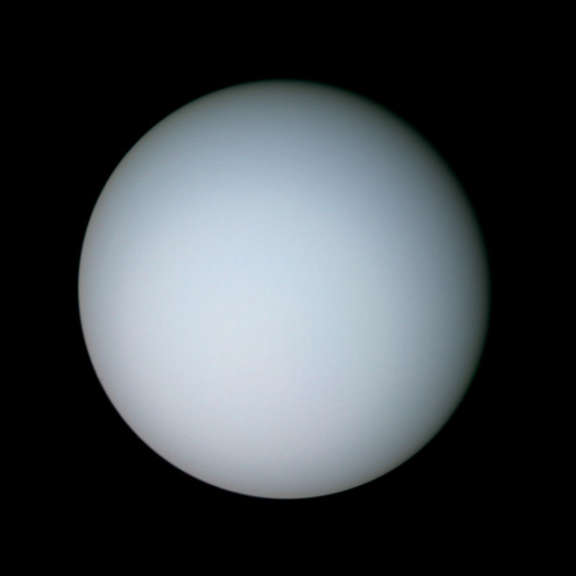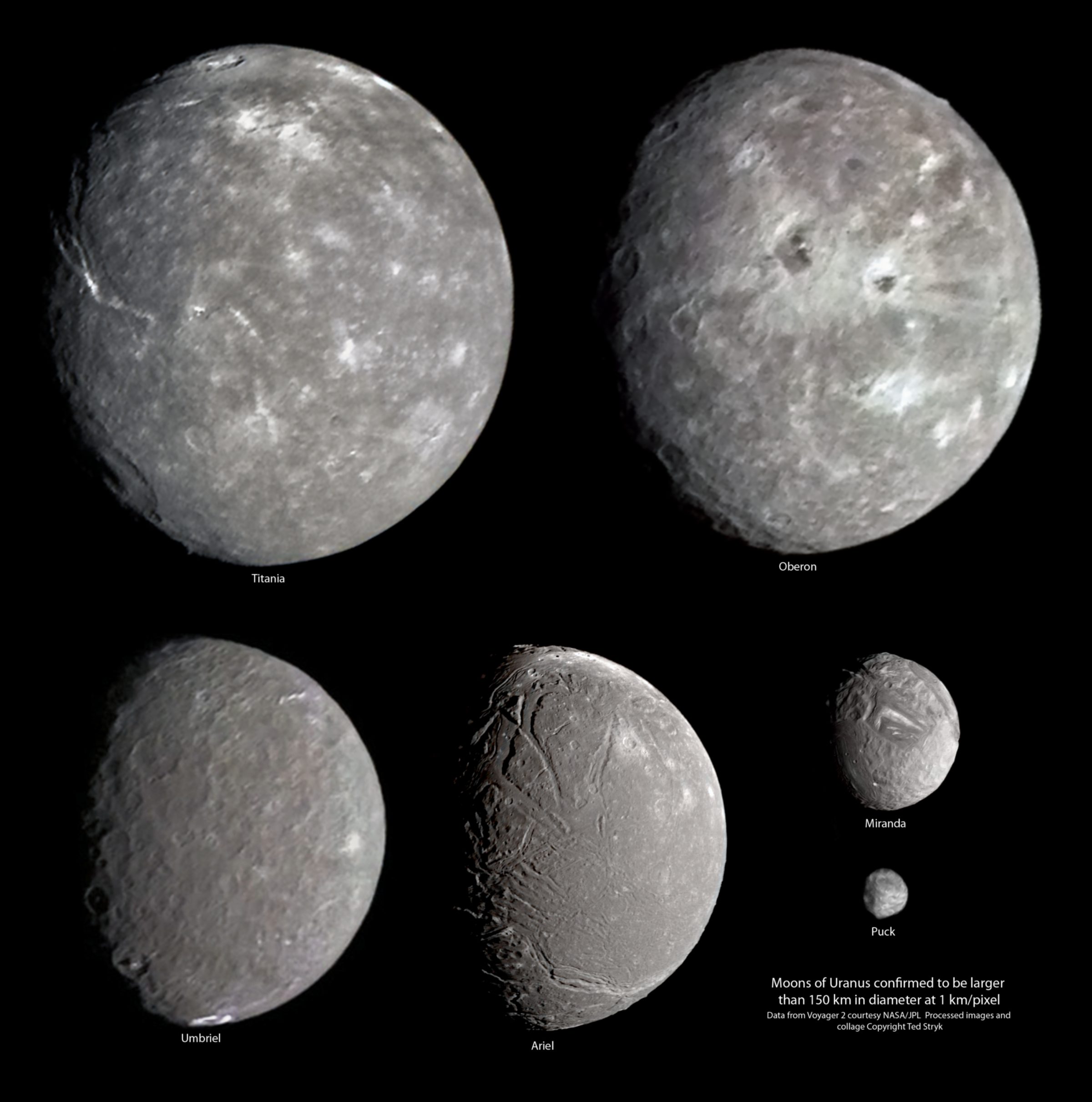Jason Davis • Jan 29, 2024
Uranus' biggest unsolved mysteries
Distant, icy Uranus has puzzled scientists for decades. From its sideways spin to its mysterious magnetic field, the oddball world has many secrets waiting to be revealed.
Uranus notably orbits the Sun on its side. Its rings spin like a coin on a table as seen from Earth, making a full revolution every 84 years — the time it takes the planet to orbit the Sun. How Uranus ended up in this orientation is one of the many questions we have about the dim, faraway world.
Voyager 2 became the first and only spacecraft to visit Uranus in 1986, revolutionizing our understanding of the planet. Since then, scientists have continued to study Uranus with ground and space-based telescopes. But there are still many riddles to be addressed, as NASA makes preliminary plans for a new Uranus mission that could reveal the planet’s unsolved mysteries.

Internal structure
Uranus does not have a solid surface. Beneath the planet’s atmosphere lies a slushy mix of water, methane, and ammonia. A rocky core probably lies at the planet’s center.
What happens within the planet’s icy layers is a mystery, said Heidi Hammel, vice president for science at the Association of Universities for Research in Astronomy, and vice president of The Planetary Society’s board of directors.
“Does Uranus have an ocean layer and then an atmosphere layer? Does it have a solid core with a transition region, or does everything kind of blur from one layer to the next? That's a fundamental question that we just don't know.”
A Uranus orbiter would help answer this question. As the spacecraft traveled around the planet, Uranus’ gravity would tug on it, causing Doppler shifts in the spacecraft’s radio signal. This is the same phenomenon that makes an ambulance siren change pitch as it passes. By measuring these shifts, scientists could map out the planet’s gravity field, allowing them to reverse-engineer what’s happening inside the planet.
Magnetic field
When Voyager 2 flew past Uranus and Neptune, it found that the ice giants’ magnetic fields were offset from their rotation axes by large amounts. Uranus’ magnetic field is offset by 59 degrees, more than any other planet.
“It's a very complex, weird magnetic field,” said Amy Simon, a senior scientist for planetary atmospheres research in the Solar System Exploration Division at NASA’s Goddard Space Flight Center. “Uranus is tilted over on its side, so the solar wind is hitting it very differently than it would on the other planets.”
It’s not clear whether the magnetic field originates from the planet’s core the way it does on many other worlds like Earth, Jupiter, and Saturn. We also don’t know how the magnetic field has changed since the Voyager 2 flyby.
Magnetic fields are linked to auroras, which can be observed by space telescopes like JWST and Hubble. But this only shows us a small portion of a planet’s magnetic field. The only way to directly measure Uranus’ magnetic field is to fly through it with an orbiting spacecraft.

Tilt and internal heat
How did Uranus end up on its side? The leading theory is that when the planet was forming, a large object smashed into it, knocking it over. It’s possible that this impact dissipated some of Uranus’ internal heat, which leads us to another mystery about the planet: It’s the chilliest planet in our Solar System.
Uranus’ coldest measured temperature is -224°C (-372°F), making it more frigid than Neptune in some places even though Neptune is farther from the Sun. This implies that Uranus doesn’t have much excess internal heat to keep it warm. Nevertheless, the planet has strong winds and occasional long-lasting storms, said Simon.
“There is something that powers convection on Uranus, which we would typically expect to be internal heat,” she said. “The fact we don't have much internal heat, but we still see storms, is really interesting.”
Rings and moons
Like the other giant planets, Uranus is like a miniature planetary system unto itself, with a set of concentric dusty rings and a scattering of intriguing moons.
Some of Uranus’ moons could host subsurface oceans. A recent study found that the four largest moons Titania, Oberon, Umbriel, and Ariel could all have liquid water beneath their surfaces. Researchers found that the moons’ surfaces may insulate their interiors, allowing them to hold on to internal heat and maintain an ocean of liquid water.
The two largest moons Titania and Oberon may also have rocky mantles that release heat directly into their oceans. This could increase the odds of the oceans being habitable for life.

Uranus’ rings are also intriguing. Using ground and space-based telescopes, scientists were able to observe new details when the rings turned edge-on to the Sun in 2007.
“We discovered new rings that had not been detected by Voyager,” said Hammel. “It also looked like the rings had shifted. There’s lots of strange things going on, like dust moving around. Why is that? There’s a lot of mysteries there.”
Birthplace and exoplanets
The early Solar System was a chaotic place, as the giant planets jostled for position and hurled asteroids and comets towards the inner planets. But we don’t know exactly where Uranus formed and how it moved around.
Scientists can track the origins of the giant planets by measuring the abundance and properties of the noble gases in their atmospheres, and comparing that with models of how we think the noble gases were distributed in the early Solar System.
Noble gases can’t be seen by telescopes. The only way to measure them is with a probe dropped directly into a planet’s atmosphere.
“The thing that makes them hard to measure is the thing that makes them good to measure,” said Simon. “They don't interact, they don't change, and they don't form other molecules.”

Understanding how Uranus formed and moved around could help us understand other star systems.
In other systems, we’ve found a lot of planets sized somewhere between Earth and the ice giants. These super-Earths, or sub-Neptunes, seem to be common in other star systems. So why don’t we have one?
To answer this question, we need to better understand how and where our planets formed. While we’ve learned a lot about rocky planets, and to a lesser extent the gas giants, ice giants are still a mystery.
Uranus orbiter and probe
A Uranus mission has been one of the planetary science community’s top priorities for the past decade.
Every 10 years, scientists create a report for NASA called the Decadal Survey that sets priorities for the next decade of exploration. The 2013 Decadal Survey listed three top priorities: Europa Clipper, Mars Sample Return, and a Uranus mission.
Europa Clipper is set to launch this year. Mars Sample Return plans are in progress, even as it faces ongoing reviews and budgetary uncertainties. That leaves a Uranus mission as the new top priority, according to the 2023 Decadal Survey.
Rather than flying past Uranus like Voyager 2, the spacecraft would enter orbit and make a comprehensive tour of Uranus, its rings, and its moons. It would also drop a probe into the planet’s atmosphere. The mission would produce a feast of data for a wide range of space scientists.
“That's the idea behind a big flagship-type mission,” said Simon. “You get this interdisciplinary and cross-disciplinary science, because you're looking at all those aspects at the same time.”
A Uranus mission could, in theory, launch in 2031 and arrive in 2043. With NASA facing budgetary challenges and Mars Sample Return still struggling to gain momentum, that timeframe may be optimistic. Nevertheless, at some point a new mission will arrive at Uranus, becoming the first spacecraft to visit in over a half-century. The mission will usher in a new era of discovery and help reveal the planet’s unsolved mysteries.
Support our core enterprises
Your support powers our mission to explore worlds, find life, and defend Earth. You make all the difference when you make a gift. Give today!
Donate

 Explore Worlds
Explore Worlds Find Life
Find Life Defend Earth
Defend Earth

